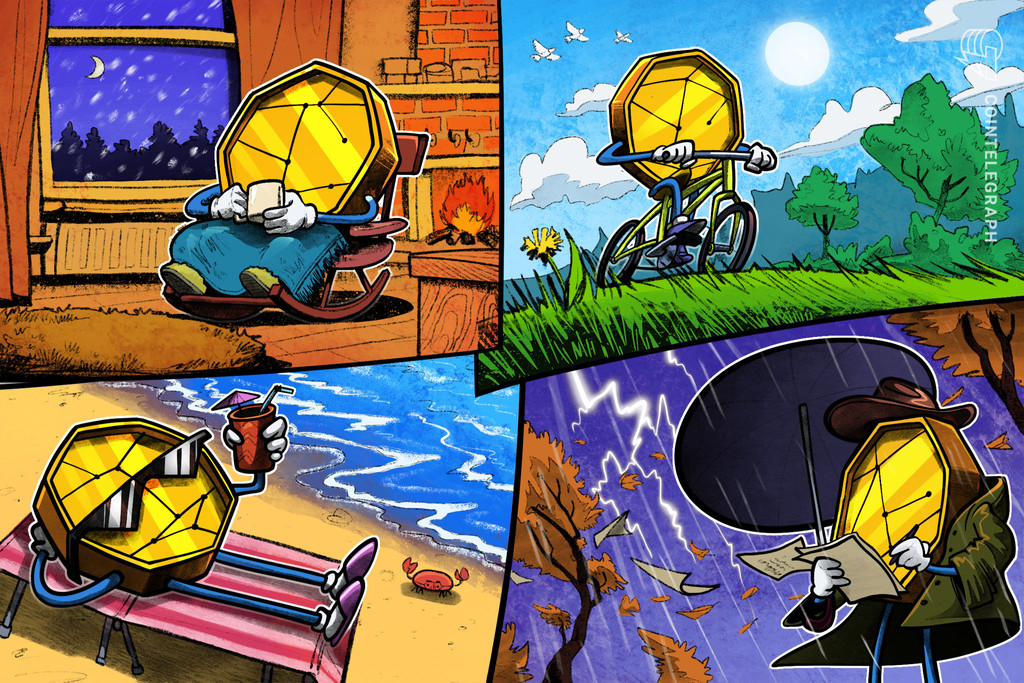What is crypto seasonality?
Crypto seasonality is the perception that Bitcoin will rise and fall over a set period of time, drastically affecting the crypto market overall.
Bitcoin (BTC) is the world’s largest cryptocurrency, as well as the first-ever one. As the first cryptocurrency, it has tons of value locked up into it at all times, and all subsequent coins, otherwise known as altcoins, are tied to it in some way.
However, Bitcoin is no stable asset. The world’s first cryptocurrency is consistently ranging in value, dropping or rising tens of thousands of dollars at any given point. Every four years, this volatility is expected to reach a peak before crashing relatively hard due to the Bitcoin halving. The Bitcoin halving is programmed into the Bitcoin blockchain. Every four years, the halving occurs, and the rewards for mining Bitcoin are cut in half, effectively ensuring less Bitcoin is coming into circulation with every block mined.
The market tends to correct after a halving, with Bitcoin’s price rising due to its more scarce nature, only to crash shortly afterward as investors cash in their newly-earned profits, and the market overcorrects as a result. While Bitcoin crashes, more investors begin worrying about their investments and may pull out to move funds into altcoins.
2.
Is crypto seasonality good or bad?
It affects everyone. But whether it’s good or bad depends on your investment personality.
Crypto seasonality can be seen as both good and bad, depending on your perspective and investment personality. For one, newer traders might see seasonality as a good thing, as they can now invest in Bitcoin at a lower price. Long-time holders, however, might despise crypto seasonality as their Bitcoin holdings are almost guaranteed to crash every four years, forcing them to wait out the lows or reinvest their holdings into altcoins.
That said, one can almost always expect Bitcoin to rise back up due to supply and demand. While this belief is never a guarantee, the leading cryptocurrency has historically risen to higher highs after each halving so far.
3.
How crypto seasonality affects investors
Crypto seasonality might force Bitcoin-only investors to gamble in the altcoin market.
When Bitcoin’s price crashes, investors are almost forced into the altcoin market to continue generating profits. That said, altcoins are entirely unpredictable, and a project that’s massively popular one day can crash suddenly the next.
The altcoin market is also full of scams. Rug pulls and deceptive marketing have led to investors being taken advantage of. Regulatory policies are still in the works and can negatively affect a trader’s experience as they develop. Exchanges can be hacked and holdings stolen. There’s really no telling what can happen in the wild west that is the altcoin market.
Sure, there are safer ways than others. Investors can buy into established passive income methods like Uniswap’s (UNI) liquidity pools, or participate in the mining or staking process of a coin rather than simply investing in it, but there’s still an inherent risk alongside these processes.
4.
Weathering crypto storms
One crypto seasonality solution exists in the form of continually accumulating assets.
While there might be multiple solutions to crypto seasonality, one crypto startup, Seasonal Tokens, is developing a potentially safer alternative to traditional trading methods. Seasonal Tokens are designed to rise and fall over the course of nine months, hoping to provide investors with a more stable alternative to Bitcoin’s downtrends.
The project breaks up its tokens into the four seasons: Spring (SPRING), Summer (SUMMER), Autumn (AUTUMN) and Winter (WINTER). Ideally, investors will buy Spring tokens while they’re the cheapest to produce and hold them over the period when they become the most expensive.
As the seasons change, investors will switch these Spring tokens to Summer tokens, which would presumably rise in value next, and so on through the later seasons. In a perfect scenario, an investor would trade Spring for Summer when Spring tokens are the most expensive to produce, and Summer tokens are the cheapest, increasing the total number of tokens they own. Then when the Summer tokens peak, the investor would trade them for Autumn tokens at their lowest point, accumulating even more.
These peaks and valleys are the cause of interval-based production cuts, similar to the Bitcoin halving. For example, in June, Spring token production will be cut in half, making it more expensive to produce than other tokens. By the time Spring rolls around again, users would convert their Winter tokens to Spring tokens and profit off of their rarity, all without contributing additional real-world funds.
Based on this model, Seasonal Tokens hopes to provide an asset that’s constantly accumulating and rising in value, giving a safe space for investors to transfer their funds during a Bitcoin bear market
